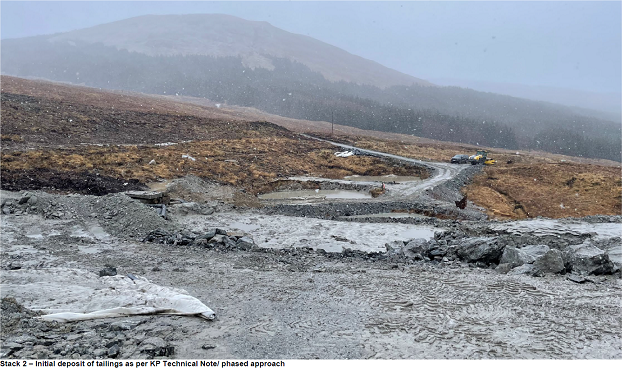
This is the most recent official photo from the Loch Lomond and Trossachs National Park Authority showing the state of the Cononish goldmine. Now imagine what might have happened if 8 inches/20cm of rain had fallen on it last weekend as happened elsewhere in the west of Scotland with no workforce available to respond?
Six months on from this photo perhaps the stack was in a less vulnerable state? With the company that runs the mine having laid off staff and heading for administration (see here) that seems unlikely. Perhaps, however, the rainfall that fell in Cononish Glenlast weekend was less than other parts of the National Park? The nearest SEPA rainfall guage is at Loch Awe and it shows the rainfall there was higher rainfall two weeks – so perhaps. With extreme rain events being so localised and the amount of rain that falls varying considerably even over short distances that does not tell us much. The point is we simply don’t know.
However, given the environmental issues at stake if everything is fine why hasn’t the LLTNPA said so publicly?
The cover up by LLTNPA senior management of what is happening at the gold mine
In June the LLTNPA refused to release a copy of the Monitoring Report for 13th March stating it would be published on 13th September. Under Freedom of Information laws where a public authority has committed to publish information at a point in the future there is no grounds for appeal to the Information Commissioner. However, as the screenshot in my post last week showed, the LLTNPA failed to publish the report as promised.
Following that post I wrote to Dr Heather Reid (convener@lochlomond-trossachs.org) to complain about this and, given the crisis at the mine and given the lack of any board approved plan to prevent an environmental disaster from happening, to request she call a special board meeting to discuss the situation and instigate weekly monitoring visits by LLTNPA staff.
On Tuesday I received an email response back from “Information Management” claiming that the report had not been published due to an “oversight” and was now available on the planning portal, that “ongoing monitoring of the site continues” – whatever that means – but nothing about a board meeting.
The monitoring report was on the planning portal (see here) but the LLTNPA had recorded the date of publication as 13th September which was wrong (I have a dated screenshot that proves this).

With the LLTNPA falsifying even the most basic of information (in this case it appears they wanted to deceive people into believing they had kept the promised timescales), no-one should trust anything they say.
I wrote back to Dr Reid asking for a proper investigation of the “oversight” and asked her to clarify what monitoring arrangements were in place and whether she would call a board meeting. Once again the response was from information management:
“The Convener has noted that the correspondence was being dealt with firstly as a complaint and now a complaint investigation and the operational nature of the content”.
What this effectively says is that questions of how to protect the natural environment in the National Park have nothing to do with the board and are purely an operational matter. Also that any concerns that the public raises about “operational matters” are also an operational matter. Both are clearly wrong: ensuring the LLTNPA has prepared for and is responding appropriately to the crisis of the goldmine is a matter of basic governance. If what Dr Reid is purported to have said is true, the LLTNPA Board might as well abolish itself, it serves no function.
I am still not totally convinced Dr Reid actually read my correspondence as any email I send to anyone in the National Park is diverted through information management and vetted. However, if she has, it appears she has been told by staff to leave it to them..
The LLTNPA should have received three further mine monitoring reports since the one it has just published. In response to my FOI request it justified its decision not to publish monitoring reports for six months on two grounds, the first that it needed to agree the reports and actions with Scotgold, the owners, of the mine, and the second “commercial confidentiality”. With Scotgold likely to go into administration it would appear there may be no-one left with whom to agree the reports and no workforce in place to implement any agreed actions so the first argument no longer applies.
As for the commercial confidentiality argument, the LLTNPA’s delay in publishing the mine monitoring reports has kept from the public information indicates the mine was in difficulties:
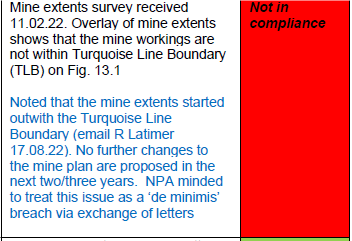
Why would Scotgold have extended the mine beyond its agreed boundaries if its estimates of the amount of gold ore in the veins on the site of the mine had been correct?
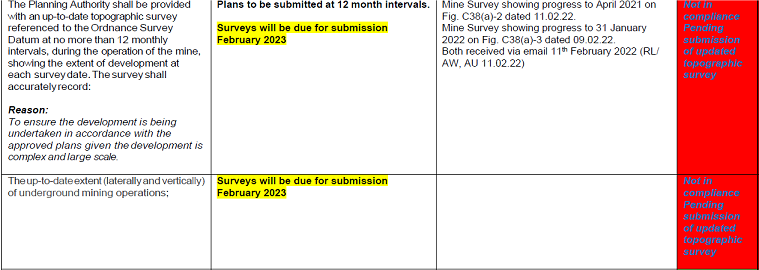
Why the delay/failure by Scotgold to produce the up to date topographic survey of the mine?

Why too has the quantity of tailings, the “cumulative waste”, been “well within the total” agreed and why was the exact amount not published?
Together they provide an indication that the mine was NOT going to plan. That should have set alarm bells ringing. Secrecy is almost always a bad thing but in this case the LLTNPA decision to withhold information on grounds of commercial confidentiality appears to have worked not only against the public interest but AGAINST the interest of shareholders, both existing and prospective.
What the March monitoring report tells us about the environmental risks at the mine
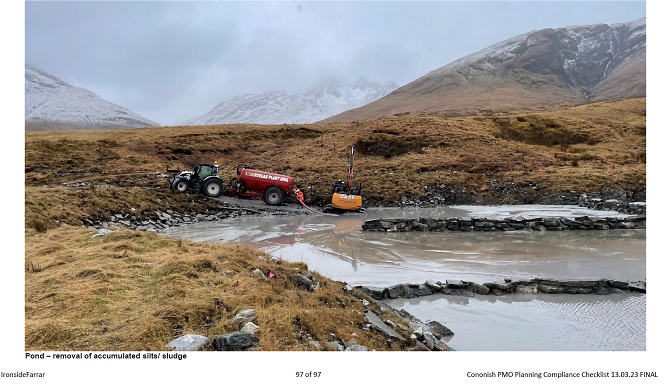
Despite the mine’s low production of gold between January and March, it was still producing large quantities of silt. This was being removed eight times a day from the settlement pond (see blue below):
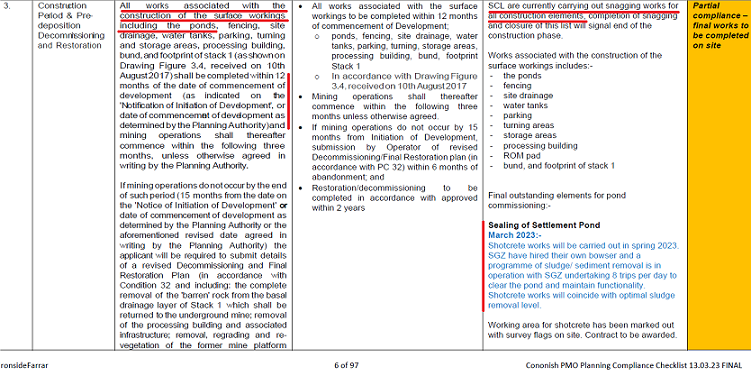
All the surface works (right column above) were supposed to have been completed within 12 months of the Notification of Initiation of Development which was received by the LLTNPA on 19th November 2018. Three and a half years later many of these are still incomplete.
Some of the original surface workings, however, including the arrangements for dealing with sediments, were not fit for purpose and in March 2021 a new settlement pond (the one in the photo) came into operation. Two and a half years later it, along with the other incomplete actions, are described as “snagging issues” (just like the funicular at Cairn Gorm (see here)!
These outstanding works have given an amber warning light in report after report. That is contrary to the LLTNPA’s own policy as explained in the monitoring reports:
“Please note that Amber actions observed on subsequent site inspections that remain unactioned will automatically switch to red”.
Reason enough one might have thought for Dr Heather Reid and the rest of the LLTNPA Board to take an interest. In the case of the new settlement pond, once leaks were identified it might initially have been justifiable to describe this as a snagging issue. The monitoring report for August 2022 stated:
“Settlement Pond – Shotcrete works to the embankment to be carried out soon. Working area for shotcrete has been marked out with survey flags on site. Contract to be awarded”.
By March the “soon” had become seven months and the action should have been classified as red. Unfortunately, with the LLTNPA refusing to publish monitoring reports we still don’t know if it has been done and to an acceptable standard.
This failure to complete the ground works has had significant consequences for the natural environment. The March Monitoring report records a number of pollution incidents including one “through” the settlement pond:

This pollution being caused by the mine is running into the River Tay catchment, famous for its salmon and supposedly protected as a Special Area of Conservation.
Another photo from the March monitoring reports gives an indication of what has been happening at the mine in wet conditions:
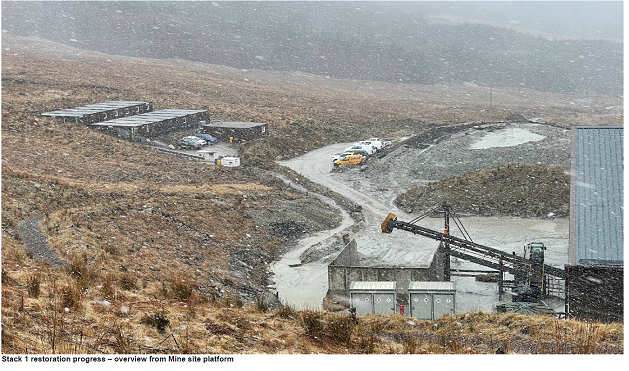
According to the March Monitoring report for Stack 2 (out of sight in this photo) “there is a stock pile area for dry material while wet tailings sit for 2 weeks in the cells to consolidate/ dry out”. Sounds sensible if you want to reduce the risk of the stacked tailings collapsing. Now note the pool of water in the centre of Stack 1 how does that fit with keeping tailing dry? Imagine what might happen if 20cms of rain fell into it – it appears to me an invitation to disaster.
Now compare what appears to be a drainage ditch on the left of the road in the photo above with a photo of the area around the portacabins from the monitoring report dated 21/3/21:
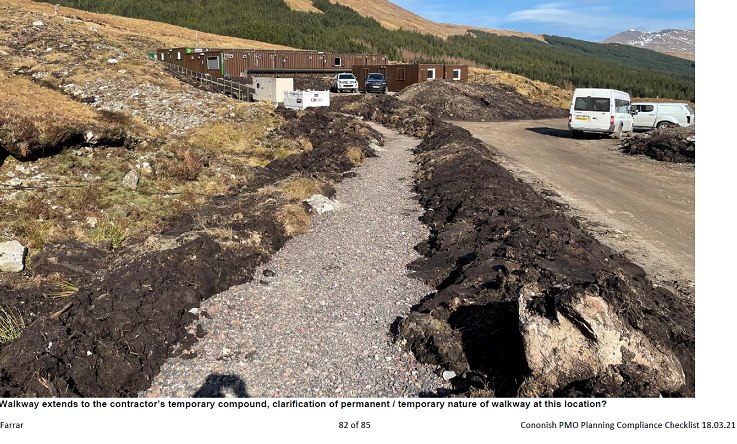
The gravel path now appears covered with silt and much of the peaty soil on the banks on either side to have washed away. It is still bare – in fact there appears to be less turf than there was two years ago – and there has been no vegetation recovery so “restoration”. It provides a good example of failed restoration work at the mine.

The failed restoration is not surprising given that it appears Scotgold has not been training staff appropriately in restoration techniques or supervising them. That all costs money of course.
While it is possible the LLTNPA forced Scotgold to use the dry period earlier this summer to fix the various water-related risks at the mine, it is equally possible that with Scotgold in financial crisis the state of the environment at the mine has deteriorated further. That is why it is so important that the LLTNPA is totally transparent about what has been going on over the last six months and its Board properly discusses the situation.
If there is no problem and everything is under control it should be simple for the LLTNPA to publish evidence to show that.
More evidence that the LLTNPA is putting Scotgold’s interest before the environment
There are several indications in the March monitoring report that Scotgold had been trying to reduce its operational costs, including those designed to protect the natural environment.
Under the travel plan, staff were required to park at Dalrigh just off the A82 and be transported up to the mine by minibus. That stopped during Covid, with the LLTNPA’s permission, but since that ran out staff have still been travelling up to the mine by car (as you can see in the overview photo above).
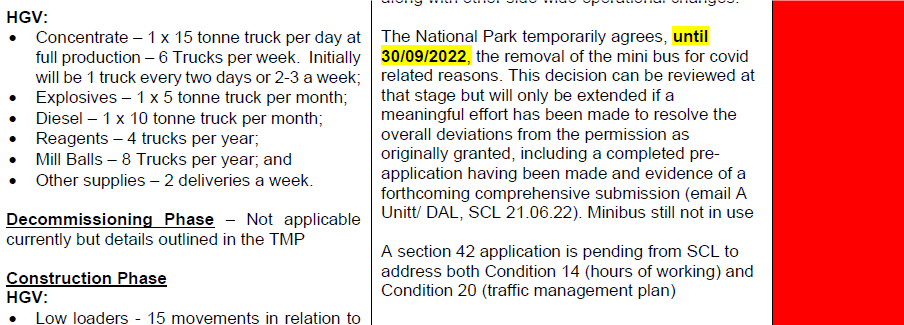
Then there is the fact that Scotgold has been going ahead new developments on the site of the mine without planning permission:
Even more significantly Scotgold have also been trying to get the LLTNPA to relax planning conditions designed to protect the natural environment.
Instead of completing the “shear key” for Stack 2 before use, Scotgold asked the LLTNPA permission to deposit tailings when it had only be partially constructed::
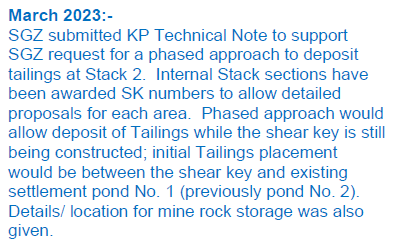
The shear key is the base that is designed to hold the tailings above together and stop them sliding.. This was an obvious cost cutting measure but the LLTNPA agreed. It is not clear from the report what consideration the LLTNPA gave to those risks but if Scotgold failed to complete the shear key before laying off staff, both the risks and the costs are likely to fall to the public sector.
Given the risks it is extraordinary that the Monitoring Report also shows that the LLTNPA had agreed that the detailed stack inspections conducted by experts could be reduced to once every six months:
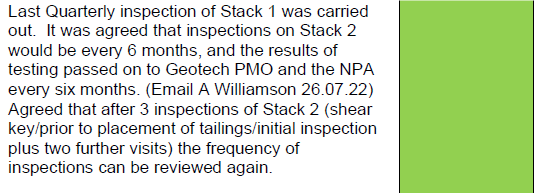
This appears a reckless decision but Scotgold has been awarded a green traffic light!
The only reduction in monitoring proposed by Scotgold where the LLTNPA did show some concern was when they proposed visits by the Landscape Clerk of Works should be reduced in frequency and limited to the summer months:
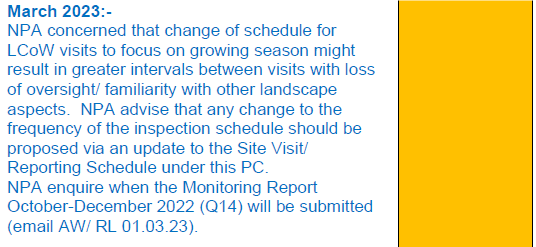
Instead of simply saying NO, however, the LLTNPA told Scotgold to go away and make a proposal through the Site Visit/Reporting Schedule.
All this raises serious questions of just whose interests the National Park Authority is serving? The primary duty of the LLTNPA has never been to keep private companies in business, it was supposed to be about protecting the natural environment. At Cononish the rot set in when Owen McKee, the Convener of the Planning Committee who steered the LLTNPA’s U-turn on the goldmine, started trading in Scotgold’s shares (see here) and while Gordon Watson, who is now Chief Executive, was head of planning.
What needs to happen
On Thursday the Scottish Government announced it was inviting local communities to bid to become Scotland’s new National Park. The news release quoted Lorna Slater (see here), the Minister responsible for National Parks, “visiting the Lomond and Trossachs National Park” and Dr Heather Reid, the Convener of the LLTNPA.
“Scotland’s National Parks are among our greatest assets. They are home to internationally renowned landscapes and nature, and provide outstanding opportunities for recreation and local communities. – They also play a crucial role in tackling climate change and protecting our precious natural environment for future generations.” (Lorna Slater)
Lorna Slater appears completely unaware of what is really going on in the Loch Lomond and Trossachs National Park, for example the environmental damage being done by industrial forestry. She has visited the National Park several times but each time is closely chaperoned by park officials and taken to selected sites where they can claim they have been doing something. She would be far better visiting places like the Cononish goldmine, Cowal (see here) or the Rest and Be Thankful. She might then develop an understanding of the many failures of our National Parks and put in place measures to reform them. That should be a much bigger priority than creating new ones.
Now over to Dr Reid:
“Biodiversity is declining faster than at any time in human history and together with the climate emergency, these twin crises are already having an impact on the country our children and grandchildren will inherit.
“The people, communities and natural assets of Scotland’s National Parks – existing and future – can contribute significantly to Scotland’s efforts to restore nature, tackle climate change and have greener economic growth.”
I doubt Dr Reid ever saw the news release because as a meteorologist – Heather the weather – she will know about the Earth Summit in Rio (1992) and all the other conferences that have been warning governments and providing evidence of the impacts for thirty years and more. The claim that the climate and nature crises “are already having an impact” comes from senior management at the LLTNPA – its been used in other park spin. They are keen portray these issues as being new so no-one holds them to account for the National Park Authority’s failure to do anything meaningful about them for almost twenty years. (The LLTNPA actually did some quite important work on these issues in its early days but that has long been swept under the carpet by the present regime).
The fact that Dr Reid allowed this misleading statement to go out in her name, however, points to the challenge and the need for reform. It is staff, not board members, who are in control in the LLTNPA. It is those staff who have told Dr Reid that the Cononish goldmine is an operational issue and not for the board. In accepting that she has made a mistake but its not too late for her to asset her right and those of other board members to start acting like board members again.
An emergency board visit to Cononish, without staff, might be a start. Forgot all the technicalities, if it looks good, it probably is good, they can publish their photos and I will eat humble pie. But if it looks bad they need to act.

Grim. Green issues/climate change have been co-opted and re-purposed since Rio 1992. The Global South have been to the fore in seeing this as a neo-liberal imperialist project. I have to agree, the free market led solutions element have been at the helm all along, eg “We Mean Business.” Greta/XR are backed to the hilt by Wall St/City of London. When they’re not hugging trees they’re starting another war. The logic escapes rational people but it makes perfect sense to $billionaires who don’t give a hoot where the loot comes from or who pays for the consequences. There’s legal barriers to justice. The Public is not all inclusive, legal superiors exclude legal inferiors. At the top there’s provision for immunity from prosecution. It’s on the UK Coat of Arms, “We can do no wrong” in Latin. The ruling class are at the end of their tether and on the rampage. Their mini-me people at the NP are just holding the fort. They’ll get their marching orders eventually.
Similar to many public bodies, what is evident here is the attempt to conn the public with ‘sweet’ words which could have been created by ChatGPT or similar. Lorna Slater spouts this kind of talk every day of her life!
It’s time for LLTNPA to take strong action to protect the environment. The transient jobs in the mine have gone – no matter what cover up LLTNPA does. Continuing the cover up makes LLTNPA complicit in creating the environmental damage that is already there and likely to get much worse, and might even leave the Board open to legal action against them personally. They should reflect on this!
your all looking in the wrong place, publishing material stolen and munipluated. all the correct updated information is avalible to the public from the mines site, and from the govenrment bodies that srictly monitor and test weekly
Hi Sean, please give the reference to the “mines site” you are referring to and explain which government bodies monitor and test the site weekly? None of the information I have used in my posts has been stolen, its been taken from public information available from the internet and elicited through Freedom of Information requests. If you tell me the information you are concerned about I can point you to the source. Nick